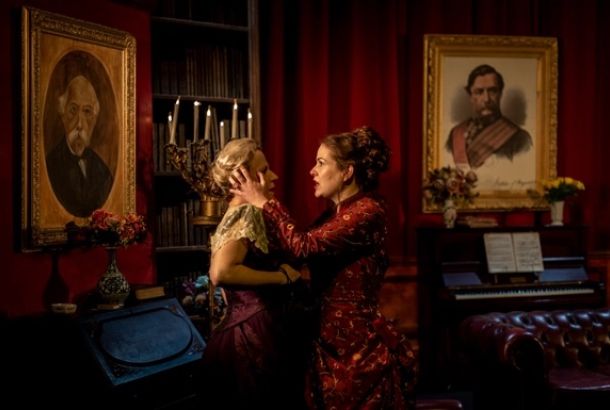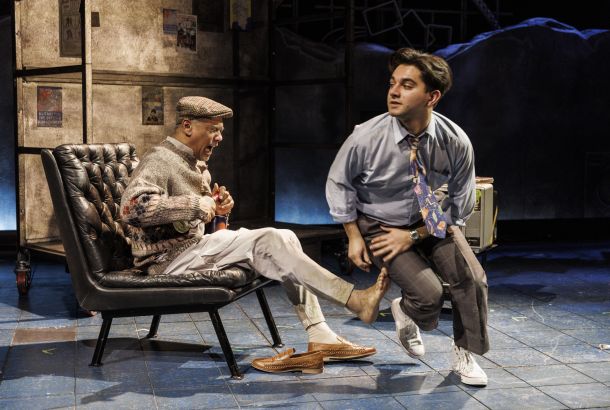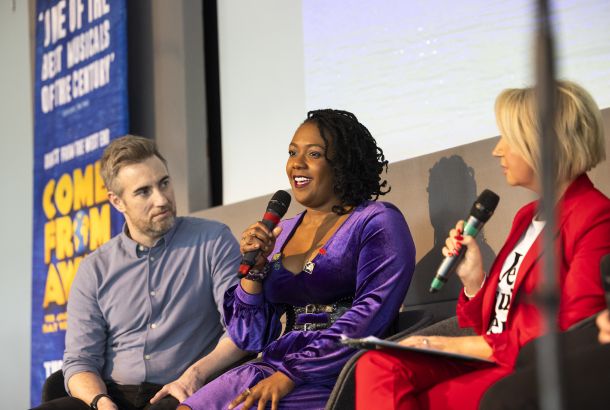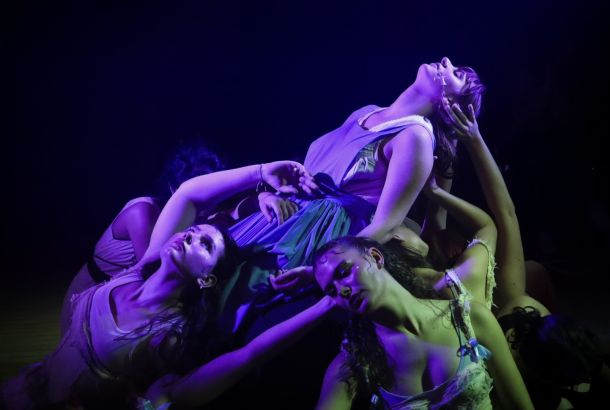
Last year, Hope Mill Theatre’s holiday musical was The Wiz – a whole decade after it last played in the UK. This year, they were even more ambitious: they have produced and directed the European premiere of Rodgers + Hammerstein’s Cinderella.
Though that might be quite the tough task, anybody who has ever seen a Hope Mill Theatre production will have had high expectations – especially after their critically acclaimed adaptation of The Wiz.
This was actually my first ever Hope Mill Theatre press night. I attended The Wiz on a different night, and sadly I did not get chance to see Passion, so it was exciting just being there – but especially because this is the European premiere of a Rodgers and Hammerstein musical!

It never fails to surprise me what the creatives at Hope Mill Theatre manage to do with such a small, intimate space. They produce full-blown Broadway musicals in what is, essentially, a black box studio – significantly smaller than my high school drama studio!
But the creatives strive to make us forget the real-life setting, especially in this production – there was even a curtain covering the stage, a convention in bigger theatres that I have never before seen in a studio. It was a sweet touch that added a feeling of majesty to the production – before it even began.
The curtain stayed down for the beginning of the opening number, with impressive visuals projected on to it – and when the curtain lifted, they continued to be projected on the wall at the back. Projections and moving images are becoming more common in musical theatre, and for a small theatre like Hope Mill – that does not have the capacity for whopping pieces of set – they really help bring the story to life.

The ensemble-led opening was followed by a scene in the forest, lead by Prince Topher (Jacob Fowler of Since September, who I recently interviewed), who was accompanied by an entourage. An hilarious moment came when his soldiers put their shields together to make the image of an horse. It was a creative, cost-efficient way to bring a horse into the action, and the audience loved it.
The production poked fun at itself when the stage span around to reveal the actors behind the shields. The actors realised they had been seen by the audience, and that the horse was no longer visible, so they freaked out. It was a brilliant breaking of the fourth wall that created a pantomime-esque feeling for this holiday musical.

Some of the set pieces, however, were pretty splendid, such as the golden carriage (moving images were used to show the pumpkin transforming into the carriage, before stencil-like set pieces came together to form a carriage).
Whilst Cinderella was riding the carriage, a couple of actors came onstage with small models of the horse and carriage; they whirled them around, creating a wonderful, whimsical atmosphere. There were so many clever creative decisions that made this production feel special and unique, no matter how small and “alternative” they were.
Some of the costumes were a little pantomime-y (the Stepsisters’ dresses were wonderfully whacky, but some of the supposedly gorgeous gowns were a little gaudy) but, for the most part, they were beautifully designed.
I particularly enjoyed all of the ballgowns at the, well, ball, and I loved the creative decision to leave Cinderella without a mask. She has been magically transformed from a bumpkin into a Princess, until the clock strikes 12: that is the mask, or, rather, the guise. But will the Prince still love Cinderella when he sees the real her? we wonder.
I could talk about the dazzling design forever, but I must also comment on the incredible cast.

The cast is lead by Grace Mouat, who is best-known for being a swing in the original West End and touring production of Six and the world premiere of & Juliet (in Manchester, before transferring to the West End).
Mouat injured herself during Cinderella‘s second preview, and whilst she completed the show (for the show must go on!), she had to take time to recover, and her understudy stepped in. The press night was thus postponed by almost a fortnight, allowing Mouat time to recover and step back into the role.
Having seen Mouat twice before (when I saw Six, she played Catherine Parr, my favourite character), I had high expectations, and she did not let me down. She has the voice of an angel and the charisma of a fairy. She’s a star-in-the-making, and I’m thrilled to see her finally getting the recognition that she deserves.

The male lead, Prince Topher, is played by the aforementioned Jacob Fowler. Fowler’s voice is warm, rich and powerful, and he was extremely likeable as the refreshingly not-so-princely Prince. The Prince might not be “Charming”, but Jacob sure is.
Rather than “Charming”, this Prince goes by: His Royal Highness Christopher Rupert Vwindemier Vlandamier Carl Alexander Francois Reginald Lancelot Herman Gregory James, or “Topher” for short!
His full-name was sang many times, sometimes accompanied by grandiose descriptions and honorific titles, such as “slayer of dragons” and “no friend to gargoyles”. Whilst Topher tired of hearing his ridiculously long name sang over and over again, I never did!

The Fairy Godmother (aka “Crazy Marie”) is played by an Australian actress of East Asian ancestry (as I like to say, representAsian): Julie Yammanee (Here Lies Love – original UK cast; Bonnie & Clyde The Musical In Concert). Her powerhouse vocals blew the audience away.

My loyalty always lies with the female villain, and I’ve always loved the Wicked Stepmother. Annie Aitken did not disappoint as Madame. She possessed a delicious, devious gravitas, and you could not help but love (to hate) her.
Like Yammanee, Aitken is Aussie, and she has had a successful career over there, starring in the original casts of Muriel’s Wedding and Melba (as Melba) and the original Australian cast of A Gentleman’s Guide to Love and Murder. It’s an honour to now have her gracing British theatres!
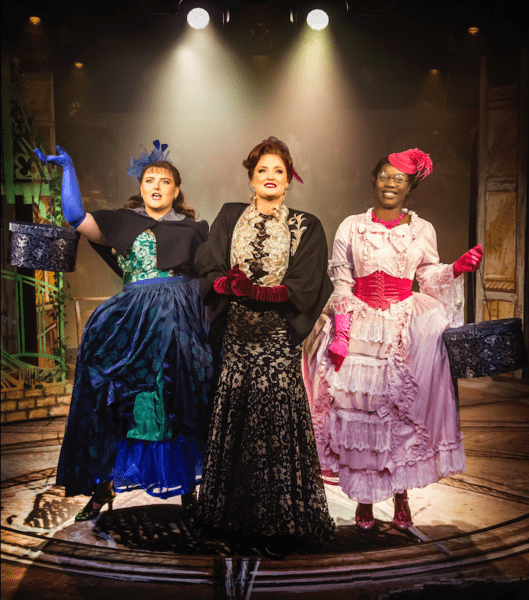
The stepsisters, meanwhile, are played by the charismatic Katie Ramshaw (Charlotte) and the endearing Olivia-Faith Kamau (Gabrielle).
Charlotte is your typical pantomime-y stepsister, but the 2013 Broadway production has completely reimagined Gabrielle. Whilst even Disney made one of the stepsisters sympathetic (in Cinderella 2, Anastacia falls in love with a baker, much to her mother’s chagrin), this production renders Gabrielle a secondary protagonist – and a victim of her mother’s wicked schemes.
Thus, the iconic number ‘Stepsister’s Lament’ (my favourite number in the piece) is performed by Charlotte and the other women longing for the Prince, with no Gabrielle. At first, I wasn’t sure what to think, but the chemistry between the competing damsels was so captivating that I was quickly sold; I think this version might actually be better.
The reimagining of Gabrielle is but one refreshing change in the 2013 Broadway production. The most noticeable is, of course, the theme of social justice: Gabrielle falls in love with a revolutionary (even worse than a baker), and Cinderella opens the Prince’s eyes to the injustice in the Kingdom, caused by the Prince’s corrupt regent, who has been ruling since the demise of his parents.

The production also seeks to make Cinderella more of an active heroin, and it achieves that, in part, through three small twists, which involve the glass slipper (at the ball, the banquet, and, yes, even the slipper-wearing ceremony).
Save for the little twist at the end of the first act, the plot so far had followed the original quite closely. Just before the second act began, my friend, Sally, joked, “I wonder what happens next,” for everyone knows the story of Cinderella – but not this story.
I bumped into Jacob during post-show drinks and repeated a conversation we’d had in our interview about classic musicals, such as Rodgers and Hammerstein productions, feeling dated and irrelevant. We both agreed that musicals should be updated tastefully and cleverly, and this production succeeds in doing that. It breathes new life into a story that we have heard time and time again. We can still appreciate the timeless story and the tantalising music – but it feels relevant.
Cinderella runs at Hope Mill Theatre until December 11.
